The Chicago Plan Commission has approved the Bronzeville Lakefront Megadevelopment planned for the former Michael Reese Hospital site in Bronzeville. The 71-acre site spans a large parcel of land from E 26th Street to E 31 Street from north to south, and from S Martin Luther King Drive to S Lake Park avenue from west to east respectively. The existing Prairie Shores residential complex is included in the scope of this project, but will remain unchanged.
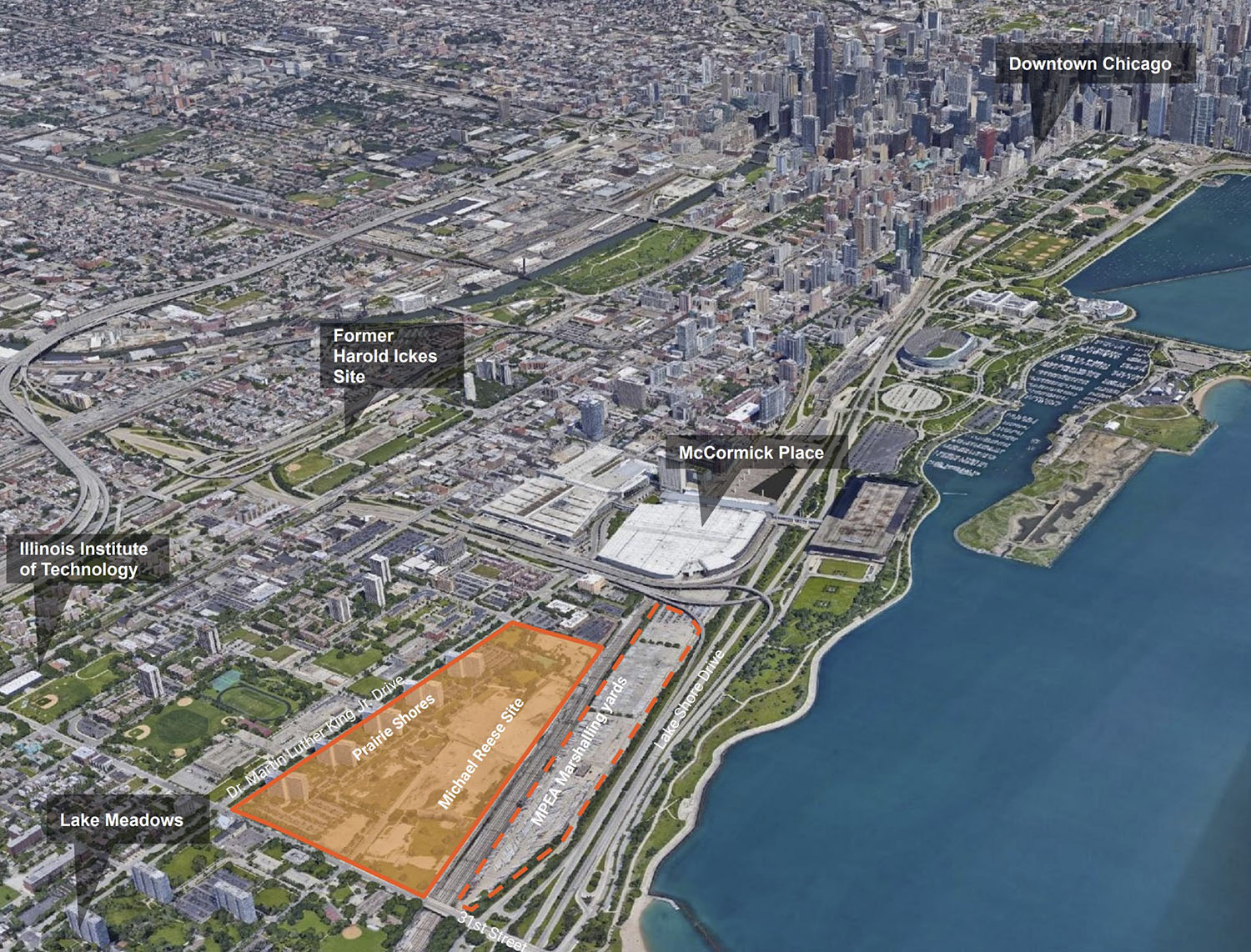
Aerial View of Bronzeville Lakefront Development Site. Diagram by GRIT Chicago
The plan comes from a development team called GRIT Chicago. This group comprises Farpoint Development, Loop Capital, Draper & Kramer, Chicago Neighborhood Initiatives, McLaurin Development, and Bronzeville Community Development Partnership. Skidmore Owings & Merrill is the lead architect for the design.

View of Bronzeville Lakefront Development Site. Diagram by GRIT Chicago
The 48-acre site of the former hospital was purchased by the city for $91 million in 2009 as part of their failed Olympic bid. The site is empty except for the Singer Pavilion, which will be adaptively reused. The Metra tracks are located on the eastern edge of the site, with an existing stop at E 27th Street. The MPEA Marshalling Yards is east of the Metra tracks, where the developer has a future goal of redeveloping the land as a future phase of this development. It is not part of this Planned Development.
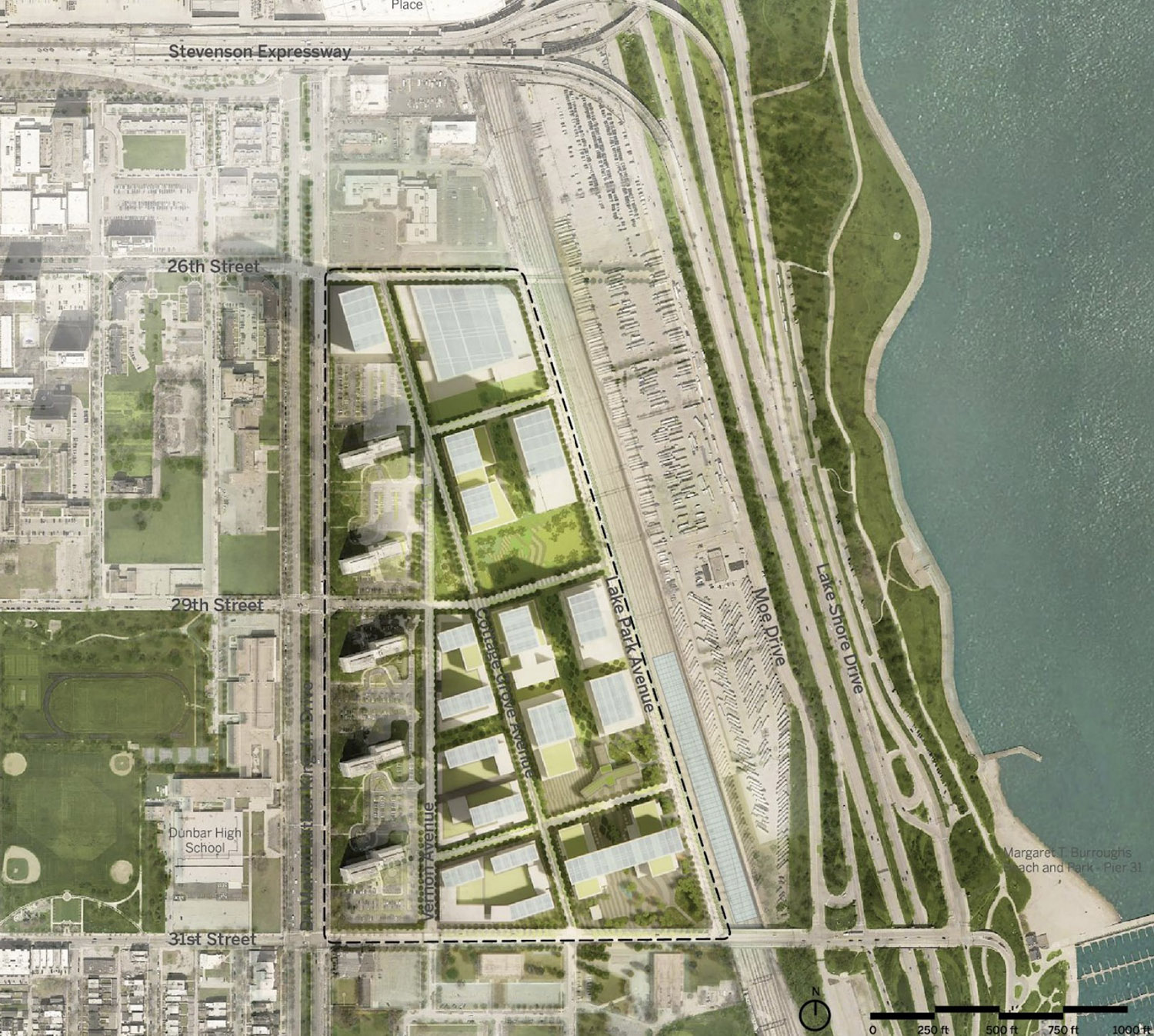
Top View of Bronzeville Lakefront Development. Rendering by GRIT Chicago
The project will have a multi-phase approach, including mixed-use development with new retail, commercial, cultural, and community, and residential uses with parks and open space included. The site has been divided into three sub-areas, where Sub-area 3 is the existing Prairie Shores. Sub-areas 1 and 2 are the scope of the new construction in the former Michael Reese Hospital site. With a gross site area of just over 3 million square feet, the development will have a maximum residential count of 8,653 residential units. This is broken down into the 1,867 existing from Prairie Shores and 6,786 new residences. The plan allows for 9.3 million square feet of total floor area, paired with 10 acres of open space. The site will have a maximum floor area ratio of 4.06.
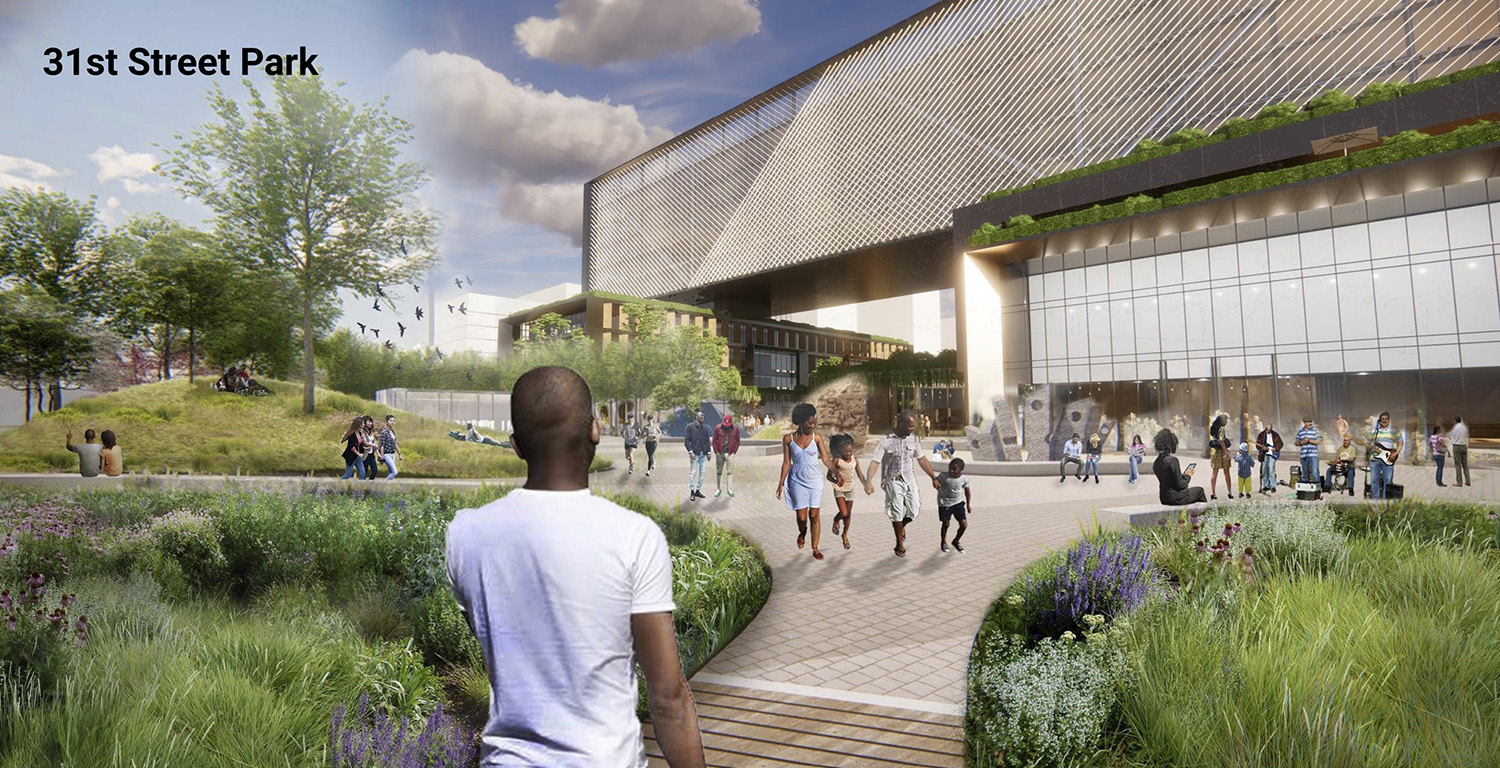
View of 31st Street Park at Bronzeville Lakefront Development Site. Rendering by GRIT Chicago
The overall development will be governed by a set of design guidelines. Massing and orientation of the new buildings will consider access to light, air, and views, while podiums will have a height and scale appropriate for the surrounding neighborhood. Guidelines are poised to encourage a variety of façade treatments with rooftop mechanicals screened from view. Parking and service areas will be integrated into the buildings, screened from the public realm, and generally accessible from S Lake Park Avenue.

Streetscape of Bronzeville Lakefront Development. Rendering by GRIT Chicago
More guidelines for the activation of ground floors and streetscapes have been included. The developers will prioritize retail and public uses on ground floors of the buildings facing the primary streets within the site. Retail space, lobbies, and public uses will have a high degree of transparency and be accessible to all. Drop-offs and clear access routes to building entries and retail will be incorporated. Parking and service entries will be prohibited or limited on primary streets, with driveway widths limited. Ground-floor uses are designed to coordinate with adjacent open spaces.

Street Network for Bronzeville Lakefront Development. Rendering by GRIT Chicago
The project scope includes the reorganization of the street network on the site. This action will reconnect the site to the surrounding urban context. The new street network will use a regular grid that allows for phasing and connectivity to the rest of the city. This will also leverage existing infrastructure and existing intersections will be improved. The existing Metra station at E 27th Street will possibly be relocated to E 31st Street.
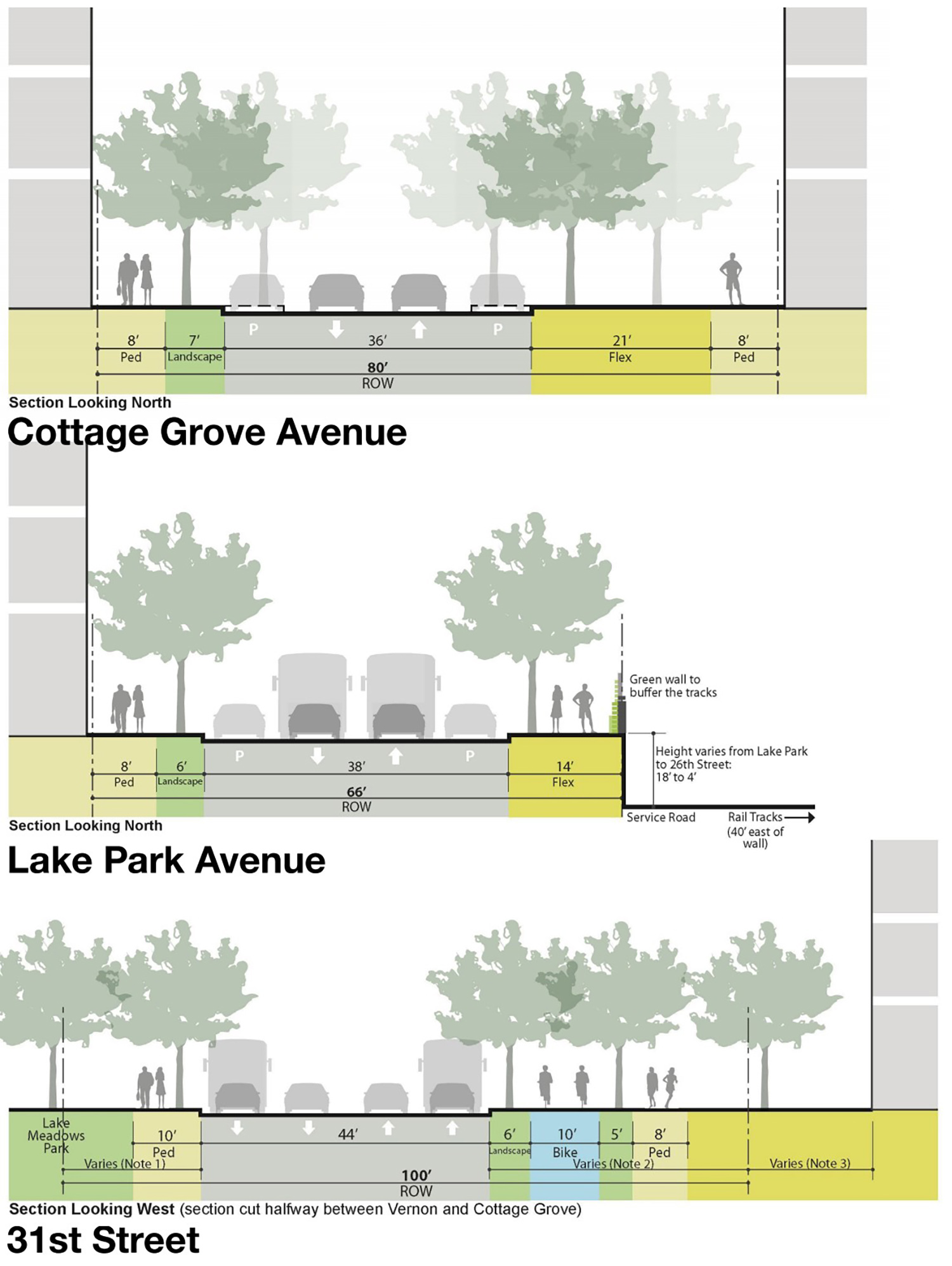
Street Sections for Bronzeville Lakefront Development. Rendering by GRIT Chicago
Streets will be designed and improved to prioritize pedestrian safety. S Cottage Grove Avenue will be restructured as a community main street. The 80-foot-long right-of-way will have an offset configuration to allow for an enhanced pedestrian experience, with a flexible space along the street for outdoor space. S Lake Park Avenue will be used as a neighborhood street, supporting parking and service to the future buildings. A green buffer will be placed along the Metra tracks to make it more pedestrian friendly. E 31st Street will have a 100-foot-long right-of-way, where bikeways will be shifted off of the street into a dual-direction bike lane on the northern side of the street.
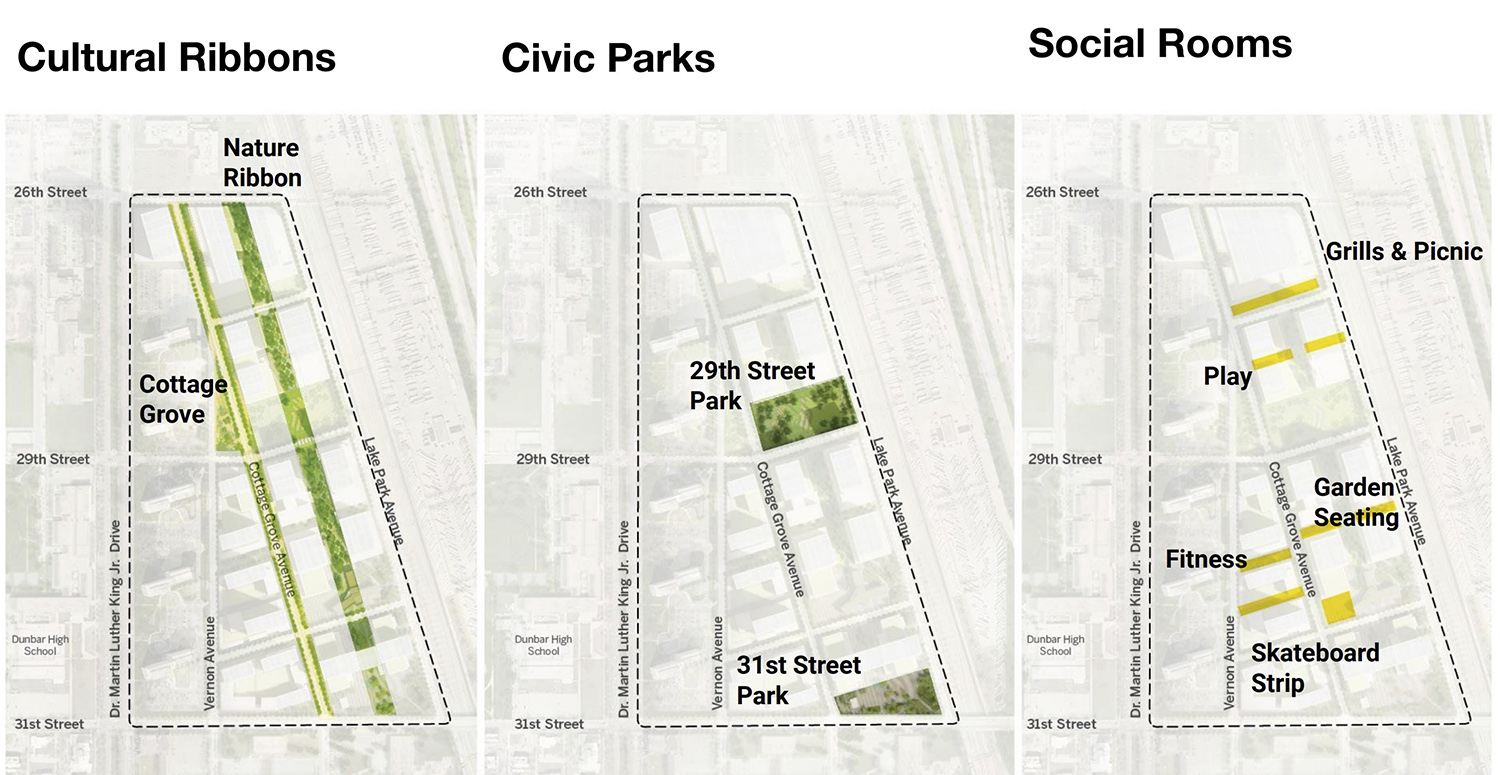
Open Spaces at Bronzeville Lakefront Development. Rendering by GRIT Chicago
Spanning 10 acres, the landscape of the project will be a series of open spaces that will be woven together to reconnect the site to the community and the city, capturing the spirit of Bronzeville. The design of the landscape will continue to be refined with city and community input as the development continues. A cultural ribbon will act as a secondary spine through the development. Civic parks at E 29th Street and the 31st Street Park will be created. The 31st Street park will have a seasonal plaza and pavilion, natural gardens, and be the beginning of the cultural ribbon. Other outdoor spaces include grill and picnic spaces, playgrounds, fitness spaces, garden seating, and a skateboarding strip.
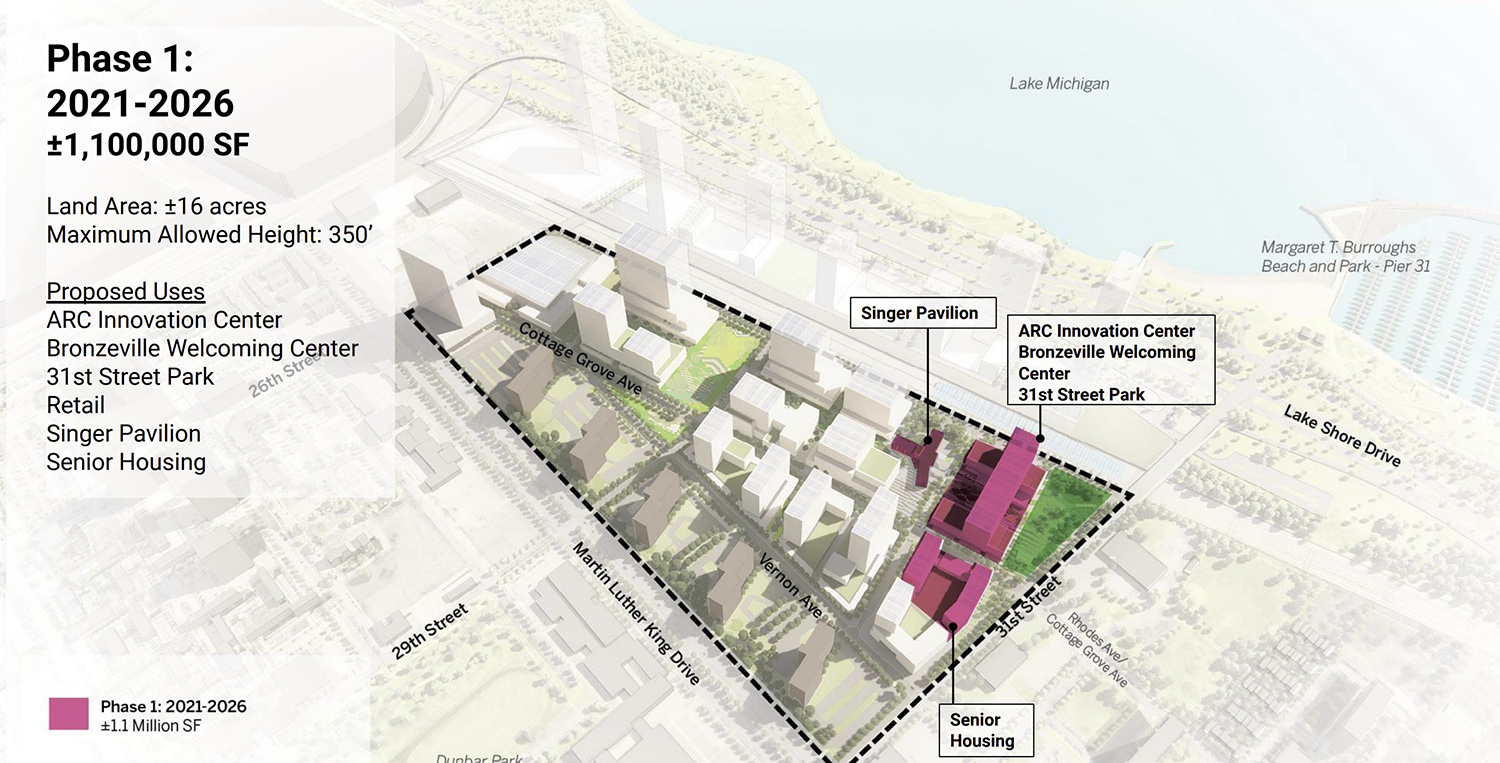
Phase 1 of Bronzeville Lakefront Development. Rendering by GRIT Chicago
Phase 1 of the project will span from 2021 to 2026, including 1.1 million square feet. The first building of the plan will be the ARC Innovation Center and Bronzeville Community Center. Spanning 500,000 square feet and poised to rise 178 feet, the building will be anchored by Sheba Medical Center and the Bronzeville Community Center. The ground floor of the building will hold multiple retail spaces and the community center. The upper portion of the structure will hold laboratories and office space for life sciences tenants.

ARC Innovation Center at Bronzeville Lakefront Development Site. Rendering by GRIT Chicago
The building is composed of two podia topped by a bridge-like main program volume. This creates a gateway to Singer Pavilion and the larger site. The community center will face 31st Street park with a multistory space for signage and branding. The base will have a diverse collection of programs, lush plantings, and textured materials. It will be broken up with brick and stone pavilions topped by outdoor terraces. Angled panels will make up the rest of the base façade for solar shading. The upper bridge volume will reflect modernist heritage in the community and express the diagonal truss structure. Outdoor terraces will be placed at the ends of the volumes. 230 parking spaces will be located below grade.
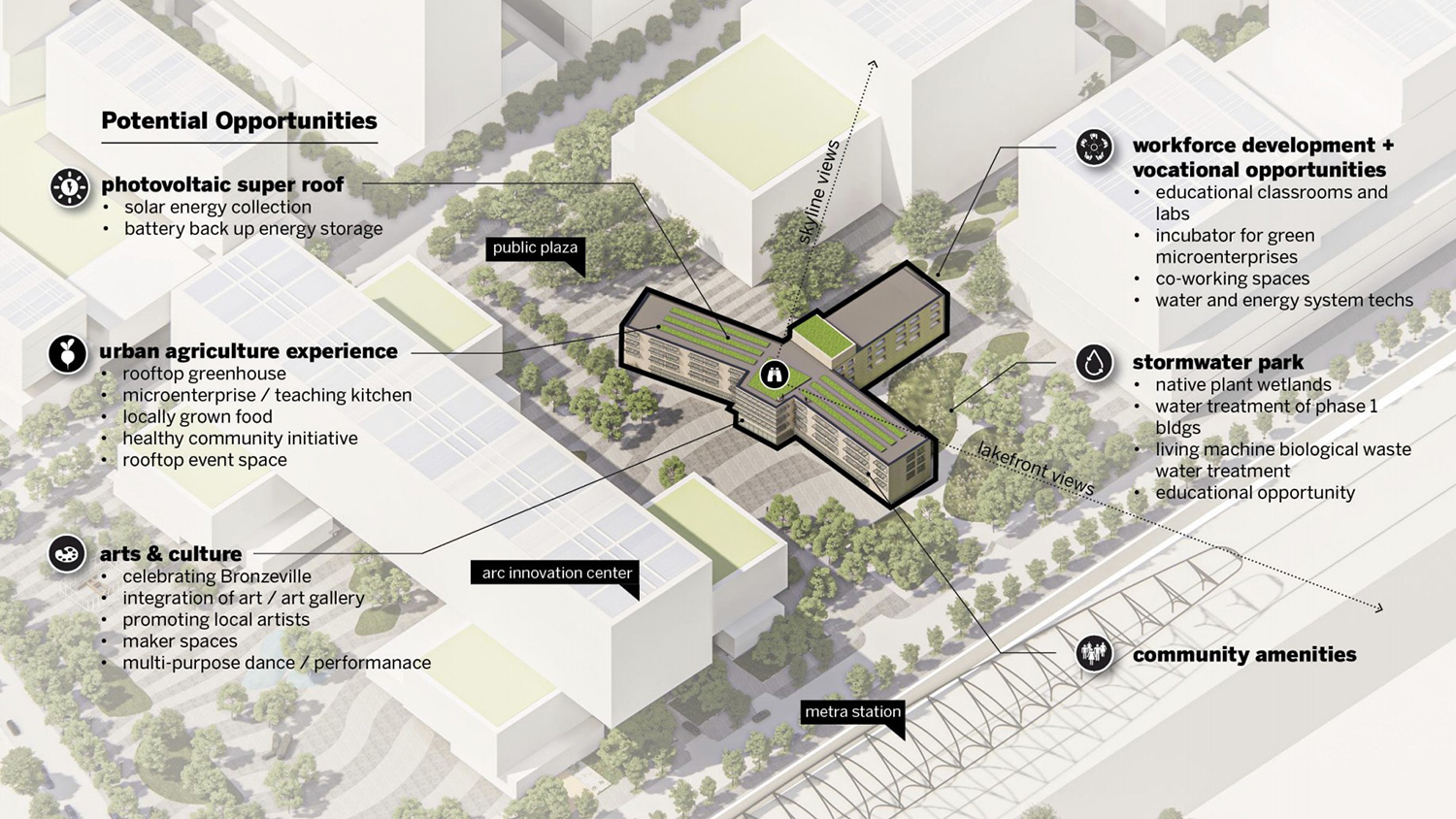
Singer Pavilion at Bronzeville Lakefront Development. Rendering by GRIT Chicago
Phase 1 will also include the adaptive reuse of Singer Pavilion and the construction of new senior housing. Johnson and Lee Architects will be behind the adaptive reuse and new construction. The adaptive reuse will honor the former hospital, with a concept of creating the world’s greenest building. The senior housing will encompass approximately 300 units and adopt a massing strategy that allows for views and will fit contextually. It will have a mix of units, common spaces, retail, townhomes, and a rooftop deck.

Senior Housing at Bronzeville Lakefront Development. Rendering by GRIT Chicago
Construction on the streets and utilities for Phase 1 will begin in 2021. Construction of the ARC Innovation Center and 31st Street Park will begin afterwards in 2022.
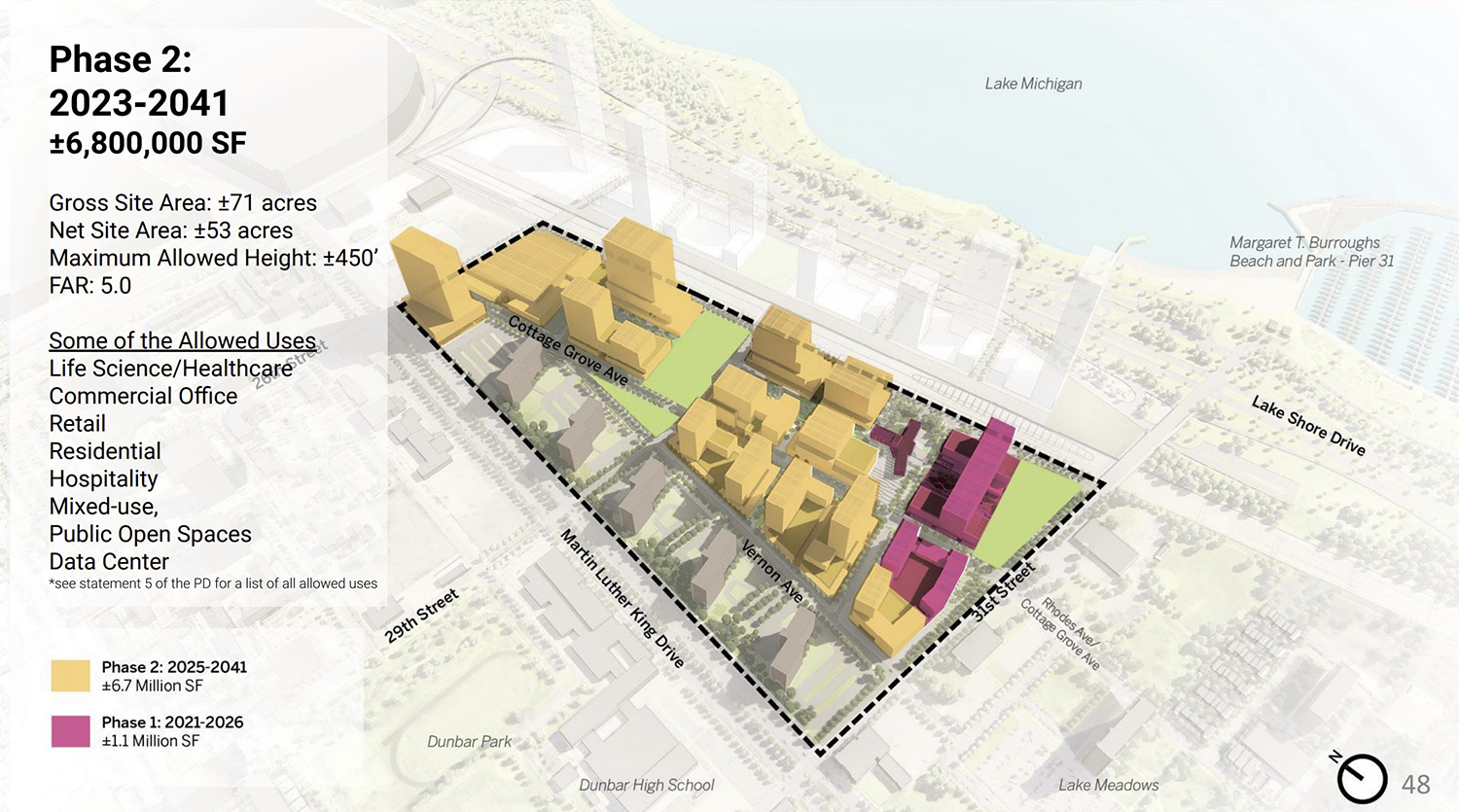
Phase 2 of Bronzeville Lakefront Development. Rendering by GRIT Chicago
Phase 2, planned to last from 2023 to 2041, will encompass 6.8 million square feet. Allowed uses for the second phase include life science or healthcare, commercial, office, retail, residential, hospitality, mixed-use, and public open space. A data center is planned as a future possibility for the first building in the northern part of the site.

View of ARC Innovation Center at Bronzeville Lakefront Development Site. Rendering by GRIT Chicago
Sustainability will be central to the entire development. The buildings will meet the WELL building standard, exceed energy code by 40 percent, include onsite renewable energy, feature landscaping, and tree planting, and receive a Sustainable Sites certification. Further efforts will include the inclusion of green roofs, a reduction in indoor water, the proximity to transit, a bikeshare sponsorship, the inclusion of bike parking, the installation of EV charging stations, the installation of a CTA digital display, workforce development, and bird protection. The project will have the goal of net positive energy by using onsite renewable energy to generate more energy than is consumed on an annual basis.
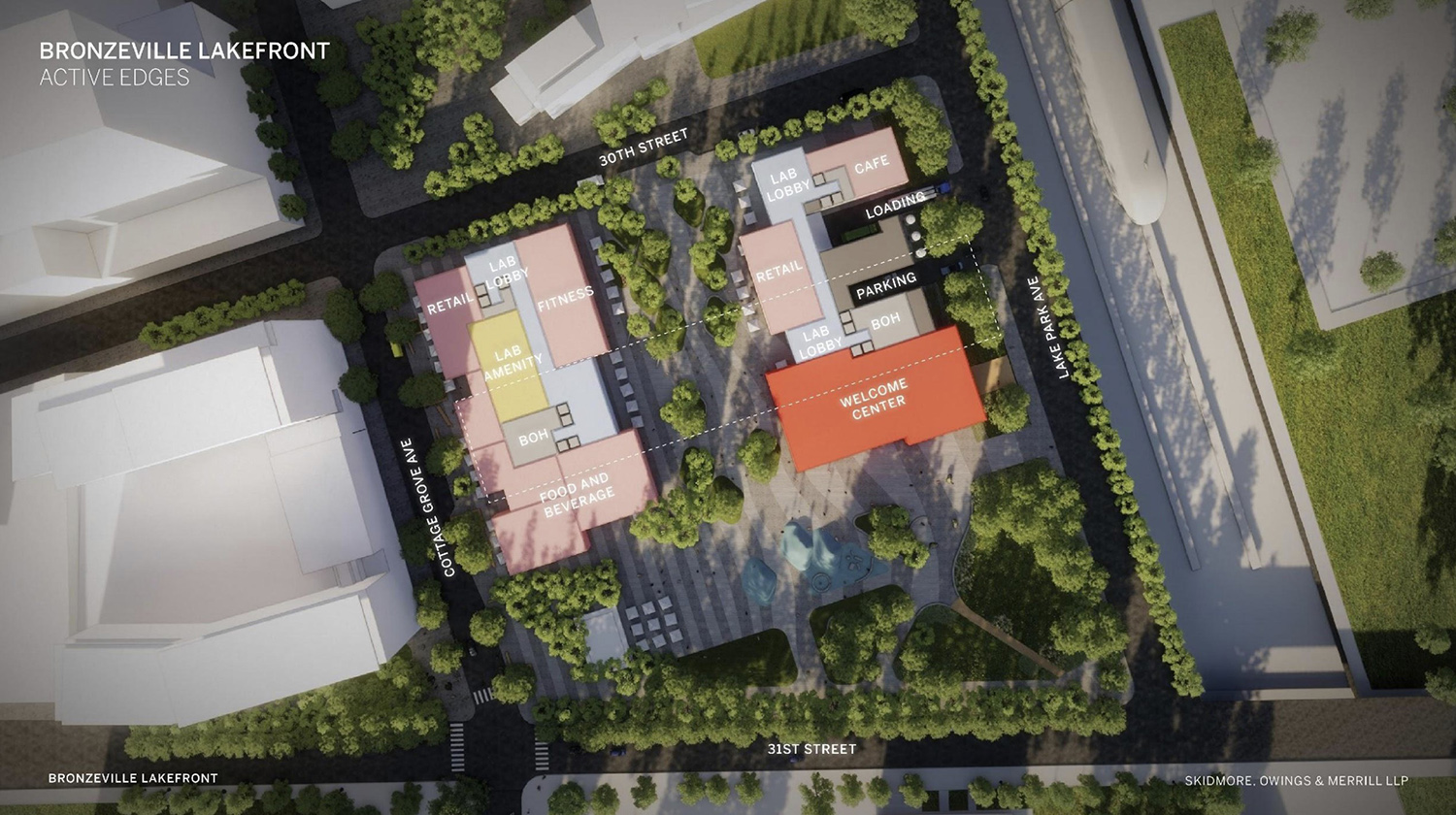
Site Plan for ARC Innovation Center at Bronzeville Lakefront Development. Rendering by GRIT Chicago
The full build-out of the site is expected to last from 2021 to 2041, spanning 7.9 million square feet. The city is still negotiating financial details with the developer. Up to $25 million will be included for either a new school or for upgrading an existing school. The development team has committed to including 20 percent of affordable units on site.
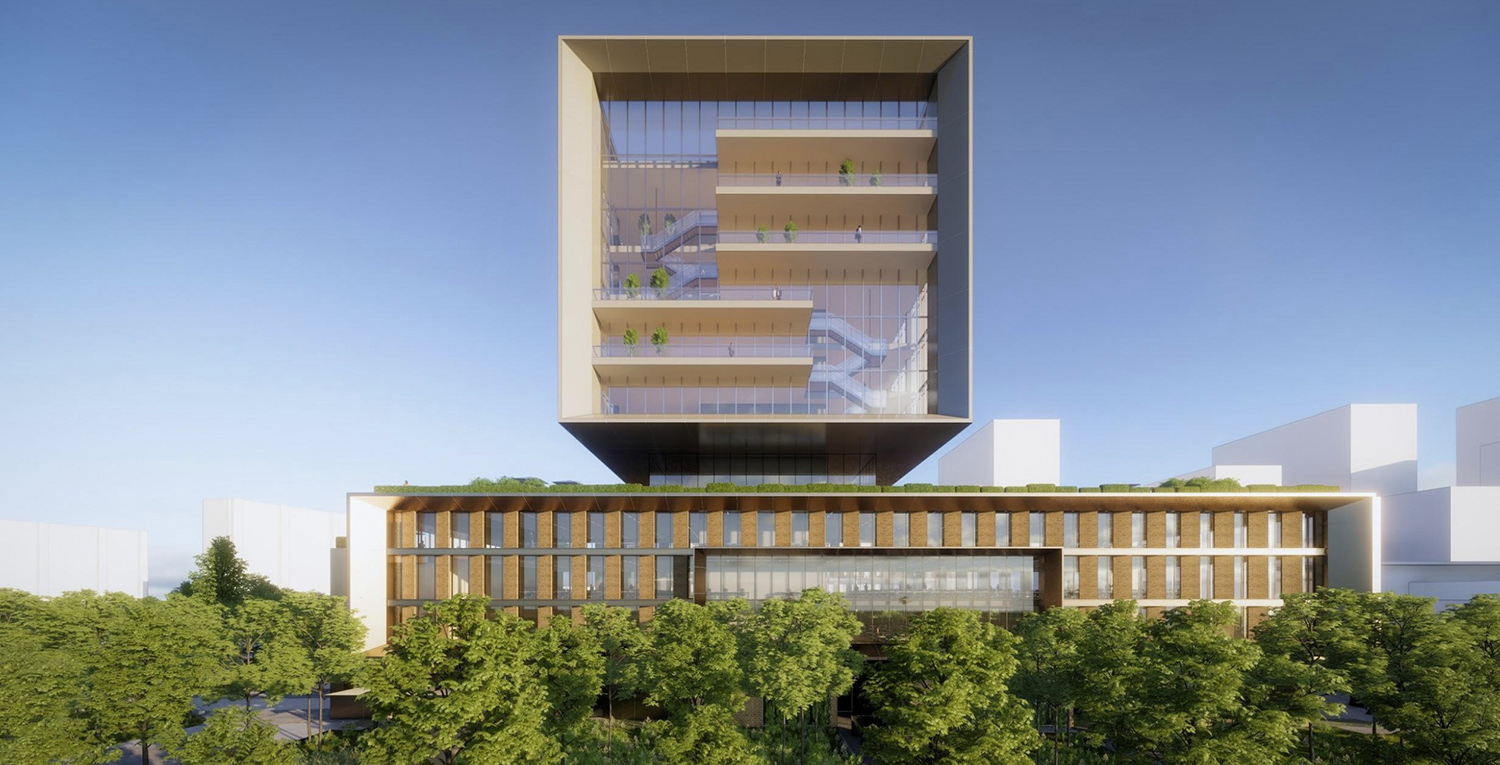
View of ARC Innovation Center at Bronzeville Lakefront Development Site. Rendering by GRIT Chicago
After this Chicago Plan Commission approval, the development will require zoning and Chicago City Council approval. The approval of this Planned Development approves the site plan of the first building. The new zoning will remove an existing Planned Development and the RM-5 designation for Prairie Shores, creating an underlying B3-5 for the new Planned Development.
Subscribe to YIMBY’s daily e-mail
Follow YIMBYgram for real-time photo updates
Like YIMBY on Facebook
Follow YIMBY’s Twitter for the latest in YIMBYnews


Nice project. Too bad it will be oh so close yet oh so far from the lakefront.
The restoration of a street grid is amazing. It would be great if the developers of this project and the MPEA Marshalling Yards could cohesively tie the projects together, cover the tracks, and provide comprehensive lakefront access to the neighborhood and surrounding areas. Pipe dream?
The city bought the land for $91 million in 2009. Curious how much revenue the city is getting for providing the land, or will it continue to own? and who is paying for the street grid update (which is great)?
The roads should include a pedestrian island. Crossing 4 lanes without some sort of safe spot in the middle is quite dangerous.
It’s taken long enough to get this off the ground. High income housing, natch. Anyway, as long as I live, I will never get the image of a McDonald’s in the lobby of Michael Reese Hospital out of my head, lol
Nice to see a plan for the space. Needs pedestrian bridges connecting 26th Street and 29th Street to the lakefront. Needs more bike lanes. Needs more housing. Needs more retail. Scrap that awful truck parking lot between this site and the lakefront and turn it into a ground level parking garage with a green park rooftop like Millennium Park. People going to the 31st Street beach can park there and enjoy a park over the parking garage.